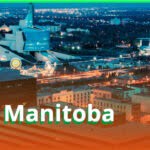Introduction
Manitoba is one of Canada’s prairie provinces, located in the central part of the country. Known for its diverse culture, rich history, and vast landscapes, Manitoba offers a unique blend of urban amenities and natural beauty. The province is characterized by its friendly communities, vibrant arts scene, and numerous outdoor recreational opportunities.
Geography and Climate
Manitoba is bordered by Ontario to the east, Saskatchewan to the west, Nunavut to the north, and the U.S. states of North Dakota and Minnesota to the south. The province’s landscape includes vast prairies, forests, lakes, and rivers. Manitoba is home to over 100,000 lakes, including the massive Lake Winnipeg, one of the largest freshwater lakes in the world.
The climate in Manitoba varies significantly across the province. It has a continental climate with cold winters and warm summers. Winnipeg, the capital city, experiences extreme temperature variations, with winter temperatures often dropping below -20°C and summer temperatures rising above 25°C. The northern regions of Manitoba have colder climates with longer winters.
Major Cities
Winnipeg: The capital and largest city of Manitoba, Winnipeg is an economic and cultural hub. Known as the “Gateway to the West,” Winnipeg boasts a diverse cultural scene, with numerous festivals, museums, and art galleries. The Canadian Museum for Human Rights, located in Winnipeg, is a notable landmark. The city is also a major center for finance, manufacturing, and transportation.
Brandon: The second-largest city in Manitoba, Brandon is an important agricultural center. It offers a mix of urban amenities and small-town charm, with attractions such as the Commonwealth Air Training Plan Museum and the Brandon Wheat Kings hockey team. Brandon is also home to Brandon University, which contributes to the city’s vibrant academic community.
Thompson: Located in northern Manitoba, Thompson is known as the “Hub of the North.” It serves as a regional center for mining, particularly nickel mining. The city is surrounded by pristine wilderness, offering excellent opportunities for outdoor activities such as fishing, hiking, and snowmobiling.
Economy and Industry
Manitoba has a diversified economy with key sectors including agriculture, manufacturing, mining, and hydroelectric power. The province is one of Canada’s leading agricultural producers, known for its production of wheat, canola, and livestock. Manitoba also has a strong manufacturing sector, with industries such as aerospace, transportation equipment, and food processing.
Hydroelectric power is a significant part of Manitoba’s economy, with numerous hydroelectric dams on rivers like the Nelson and Winnipeg providing a substantial portion of the province’s energy needs. Mining, particularly of nickel, copper, and zinc, is a major industry in northern Manitoba.
Culture and Heritage
Manitoba is known for its cultural diversity and rich heritage. The province is home to a significant Indigenous population, and Indigenous cultures are celebrated and preserved through various events, museums, and cultural centers. The Festival du Voyageur, held in Winnipeg, is the largest winter festival in Western Canada and celebrates the province’s French-Canadian heritage.
The arts scene in Manitoba is vibrant, with numerous theaters, music festivals, and art galleries. The Royal Winnipeg Ballet, one of the oldest ballet companies in North America, is based in the province. Manitoba also has a strong tradition of folk music, with the Winnipeg Folk Festival being a major annual event.
Education and Research
Manitoba is home to several reputable educational institutions, including the University of Manitoba, the University of Winnipeg, and Brandon University. These institutions are known for their research contributions in fields such as health sciences, environmental studies, and agricultural sciences.
Natural Attractions and Outdoor Activities
Manitoba’s diverse landscapes offer a wealth of outdoor activities. The province is home to numerous national and provincial parks, such as Riding Mountain National Park and Whiteshell Provincial Park, which offer opportunities for hiking, camping, and wildlife viewing. Churchill, located on the shores of Hudson Bay, is known as the “Polar Bear Capital of the World” and is a popular destination for wildlife enthusiasts and photographers.
The province’s many lakes and rivers provide excellent opportunities for fishing, boating, and water sports. In winter, activities such as ice fishing, snowmobiling, and cross-country skiing are popular.
Conclusion
Manitoba is a province of contrasts and opportunities, where urban sophistication meets natural beauty. Its diverse culture, strong economy, and friendly communities make it an attractive place to live, work, and visit. Whether exploring the vibrant city of Winnipeg, the scenic landscapes of its national parks, or the cultural richness of its Indigenous heritage, Manitoba offers a unique and rewarding experience for all.




